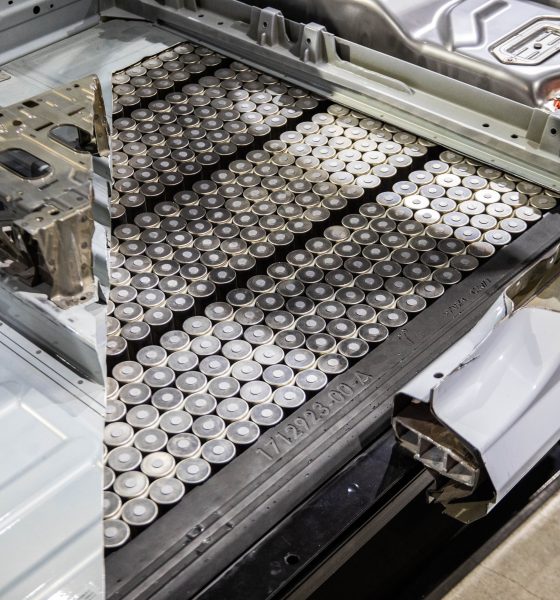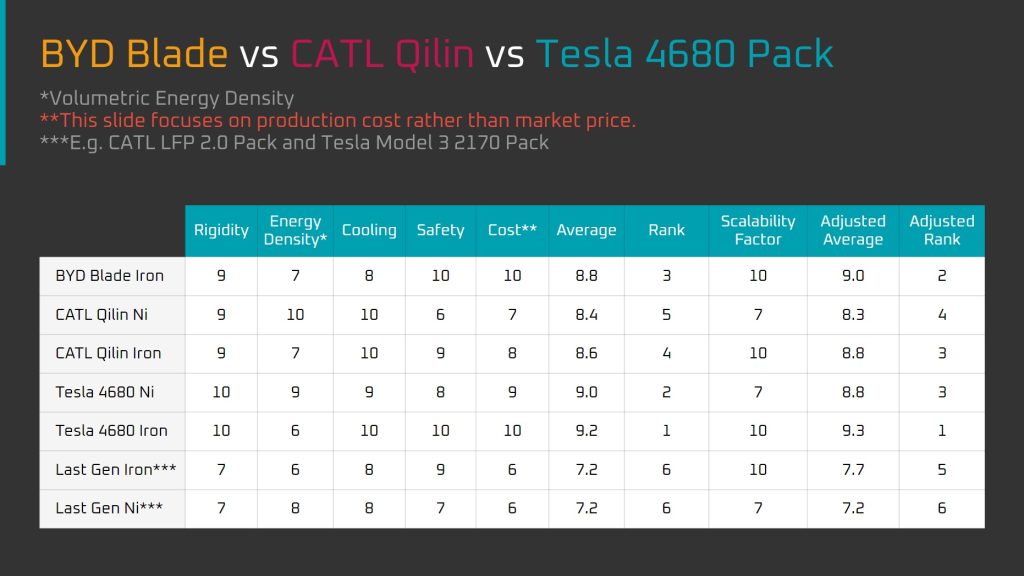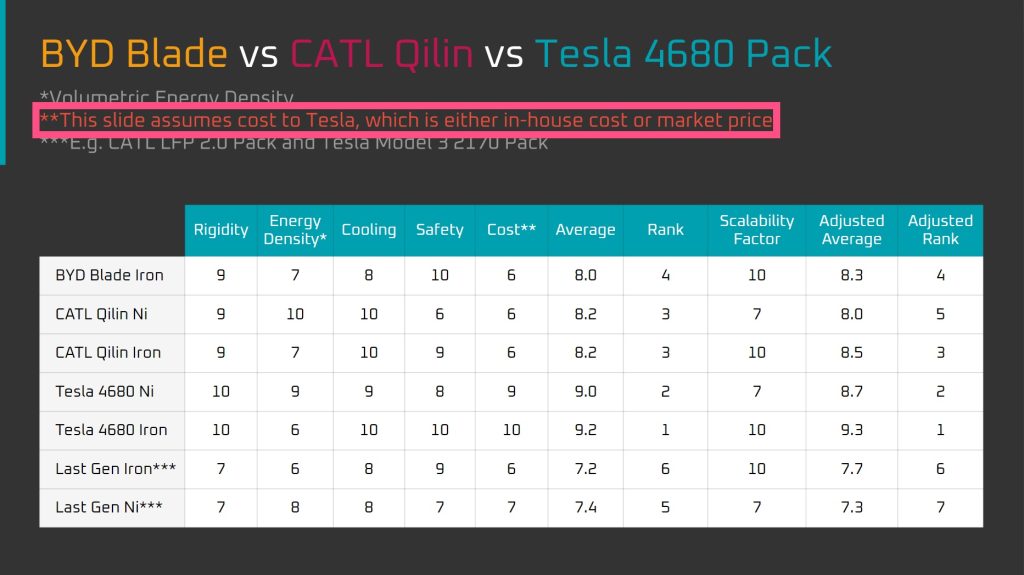

News
Tesla 4680 cells compared with BYD Blade and CATL Qilin structural batteries
The battle for the dominance of the electric vehicle sector would likely be determined by the market’s key battery makers. With this in mind, companies such as BYD, CATL, and Tesla — all of whom are exploring the structural battery form factor — have the chance to become the trailblazers of the next generation of electric car batteries.
During its Battery Day event, Tesla announced its 4680 cells, which are used alongside the company’s structural battery pack. BYD, on the other hand, has also released its Blade batteries, which also adopt a non-modular approach. CATL’s Qilin batteries are in the same segment, with its structural battery design.
Electric vehicle battery enthusiast Jordan Giesige of YouTube’s The Limiting Factor channel recently conducted a comparison of the advantages and disadvantages of Tesla, BYD, and CATL’s next-generation structural packs. Each battery pack was evaluated according to several factors, such as design, rigidity, packing and energy density, and safety, before being ranked. It should be noted that the figures used in the comparisons are drawn from estimates and materials released by Tesla, BYD, and CATL themselves, not current real-world observations.
As noted by Giesige, Tesla’s 4680 structural battery packs utilize hundreds of cylindrical cells with a cooling ribbon in between every other row of cells. A lid is then placed on top and polyurethane foam is injected into the pack. This polyurethane hardens, and the combination of the foam and the battery cells forms a rigid, honeycomb-type structure.
CATL Qilin batteries, which could be fitted with both nickel and iron-based cells, integrate thermal pads, the liquid cooling plate, and the cross bracing to create what could be described as structural cooling. The structural cooling is placed between each row of prismatic battery cells, and the cells themselves are placed into the pack directly without any modules. BYD Blade batteries use iron-based prismatic cells, though these cells are longer and thinner than those used by CATL. The cells are then stretched across the BYD Blade battery pack, allowing the cells themselves to replace conventional steel beams.

In the rankings of the next-generation batteries, the YouTube host noted that Tesla’s 4680 structural battery pack would likely be the most rigid among its peers. Tesla’s 4680 pack loses out in terms of packing density, however, as BYD and CATL’s use of prismatic cells maximizes volumetric energy density. With this in mind, and considering that CATL’s Qilin batteries can be fitted with high-energy density nickel-based cells, a nickel-based Qilin battery would likely be more energy dense than a nickel-based Tesla 4680 pack or a BYD Blade structural battery, which uses less energy dense iron-based cells.
As for cooling, Giesige noted that the BYD Blade batteries’ plate cooling would likely fall short of the Tesla 4680 pack and CATL Qilin battery’s cooling systems. In its marketing materials, CATL highlighted that cooling the sides of the Qilin battery increases the pack’s cooling area four times. Tesla’s 4680 battery also uses better cooling than BYD’s Blade batteries with its side cooling system, though it would likely not be as good as the cooling of CATL’s Qilin structural packs.
While BYD’s Blade batteries lose out in cooling, they are also likely the safest among its peers. This is because the BYD Blade battery uses iron-based cells, which have a higher decomposition and lower heat release temperature than the nickel-based cells used in Tesla’s 4680 cells and CATL’s nickel-based Qilin batteries. An iron-based Qilin battery comes second to the BYD Blade, partly due to its use of shorter and thicker prismatic cells, which may trap more heat.


A Qilin pack with nickel-based cells was ranked last in terms of safety by the battery enthusiast, as Tesla’s 4680 pack with nickel-based cells features several safety systems, such as an overpressure mechanism on the bottom of the cells themselves. Since 4680 cells are also smaller than the prismatic cells used in the BYD Blade and CATL Qilin, they contain less energy. The 4680 cells themselves are enclosed in a thick shell as well, which are about 2-3 times thicker than a conventional battery.
Overall, Giesige noted that Tesla’s 4680 cells are likely the best all-rounder compared to its peers in the structural battery segment. The overall scores of the BYD Blade and CATL Qilin batteries bode well for Tesla’s future, however, as the companies could become suppliers of the EV maker in the future. CATL is already supplying Tesla with LFP batteries today, and BYD is heavily rumored to be a Tesla supplier as well. In a way, the analysis of the next-generation structural EV batteries shows that Tesla is not alone in pushing the battery industry forward.
Watch The Limiting Factor‘s full analysis in the video below.
Don’t hesitate to contact us with news tips. Just send a message to simon@teslarati.com to give us a heads up.

Elon Musk
Tesla’s Elon Musk: 10 billion miles needed for safe Unsupervised FSD
As per the CEO, roughly 10 billion miles of training data are required due to reality’s “super long tail of complexity.”

Tesla CEO Elon Musk has provided an updated estimate for the training data needed to achieve truly safe unsupervised Full Self-Driving (FSD).
As per the CEO, roughly 10 billion miles of training data are required due to reality’s “super long tail of complexity.”
10 billion miles of training data
Musk comment came as a reply to Apple and Rivian alum Paul Beisel, who posted an analysis on X about the gap between tech demonstrations and real-world products. In his post, Beisel highlighted Tesla’s data-driven lead in autonomy, and he also argued that it would not be easy for rivals to become a legitimate competitor to FSD quickly.
“The notion that someone can ‘catch up’ to this problem primarily through simulation and limited on-road exposure strikes me as deeply naive. This is not a demo problem. It is a scale, data, and iteration problem— and Tesla is already far, far down that road while others are just getting started,” Beisel wrote.
Musk responded to Beisel’s post, stating that “Roughly 10 billion miles of training data is needed to achieve safe unsupervised self-driving. Reality has a super long tail of complexity.” This is quite interesting considering that in his Master Plan Part Deux, Elon Musk estimated that worldwide regulatory approval for autonomous driving would require around 6 billion miles.
FSD’s total training miles
As 2025 came to a close, Tesla community members observed that FSD was already nearing 7 billion miles driven, with over 2.5 billion miles being from inner city roads. The 7-billion-mile mark was passed just a few days later. This suggests that Tesla is likely the company today with the most training data for its autonomous driving program.
The difficulties of achieving autonomy were referenced by Elon Musk recently, when he commented on Nvidia’s Alpamayo program. As per Musk, “they will find that it’s easy to get to 99% and then super hard to solve the long tail of the distribution.” These sentiments were echoed by Tesla VP for AI software Ashok Elluswamy, who also noted on X that “the long tail is sooo long, that most people can’t grasp it.”
News
Tesla earns top honors at MotorTrend’s SDV Innovator Awards
MotorTrend’s SDV Awards were presented during CES 2026 in Las Vegas.

Tesla emerged as one of the most recognized automakers at MotorTrend’s 2026 Software-Defined Vehicle (SDV) Innovator Awards.
As could be seen in a press release from the publication, two key Tesla employees were honored for their work on AI, autonomy, and vehicle software. MotorTrend’s SDV Awards were presented during CES 2026 in Las Vegas.
Tesla leaders and engineers recognized
The fourth annual SDV Innovator Awards celebrate pioneers and experts who are pushing the automotive industry deeper into software-driven development. Among the most notable honorees for this year was Ashok Elluswamy, Tesla’s Vice President of AI Software, who received a Pioneer Award for his role in advancing artificial intelligence and autonomy across the company’s vehicle lineup.
Tesla also secured recognition in the Expert category, with Lawson Fulton, a staff Autopilot machine learning engineer, honored for his contributions to Tesla’s driver-assistance and autonomous systems.
Tesla’s software-first strategy
While automakers like General Motors, Ford, and Rivian also received recognition, Tesla’s multiple awards stood out given the company’s outsized role in popularizing software-defined vehicles over the past decade. From frequent OTA updates to its data-driven approach to autonomy, Tesla has consistently treated vehicles as evolving software platforms rather than static products.
This has made Tesla’s vehicles very unique in their respective sectors, as they are arguably the only cars that objectively get better over time. This is especially true for vehicles that are loaded with the company’s Full Self-Driving system, which are getting progressively more intelligent and autonomous over time. The majority of Tesla’s updates to its vehicles are free as well, which is very much appreciated by customers worldwide.
Elon Musk
Judge clears path for Elon Musk’s OpenAI lawsuit to go before a jury
The decision maintains Musk’s claims that OpenAI’s shift toward a for-profit structure violated early assurances made to him as a co-founder.

A U.S. judge has ruled that Elon Musk’s lawsuit accusing OpenAI of abandoning its founding nonprofit mission can proceed to a jury trial.
The decision maintains Musk’s claims that OpenAI’s shift toward a for-profit structure violated early assurances made to him as a co-founder. These claims are directly opposed by OpenAI.
Judge says disputed facts warrant a trial
At a hearing in Oakland, U.S. District Judge Yvonne Gonzalez Rogers stated that there was “plenty of evidence” suggesting that OpenAI leaders had promised that the organization’s original nonprofit structure would be maintained. She ruled that those disputed facts should be evaluated by a jury at a trial in March rather than decided by the court at this stage, as noted in a Reuters report.
Musk helped co-found OpenAI in 2015 but left the organization in 2018. In his lawsuit, he argued that he contributed roughly $38 million, or about 60% of OpenAI’s early funding, based on assurances that the company would remain a nonprofit dedicated to the public benefit. He is seeking unspecified monetary damages tied to what he describes as “ill-gotten gains.”
OpenAI, however, has repeatedly rejected Musk’s allegations. The company has stated that Musk’s claims were baseless and part of a pattern of harassment.
Rivalries and Microsoft ties
The case unfolds against the backdrop of intensifying competition in generative artificial intelligence. Musk now runs xAI, whose Grok chatbot competes directly with OpenAI’s flagship ChatGPT. OpenAI has argued that Musk is a frustrated commercial rival who is simply attempting to slow down a market leader.
The lawsuit also names Microsoft as a defendant, citing its multibillion-dollar partnerships with OpenAI. Microsoft has urged the court to dismiss the claims against it, arguing there is no evidence it aided or abetted any alleged misconduct. Lawyers for OpenAI have also pushed for the case to be thrown out, claiming that Musk failed to show sufficient factual basis for claims such as fraud and breach of contract.
Judge Gonzalez Rogers, however, declined to end the case at this stage, noting that a jury would also need to consider whether Musk filed the lawsuit within the applicable statute of limitations. Still, the dispute between Elon Musk and OpenAI is now headed for a high-profile jury trial in the coming months.








